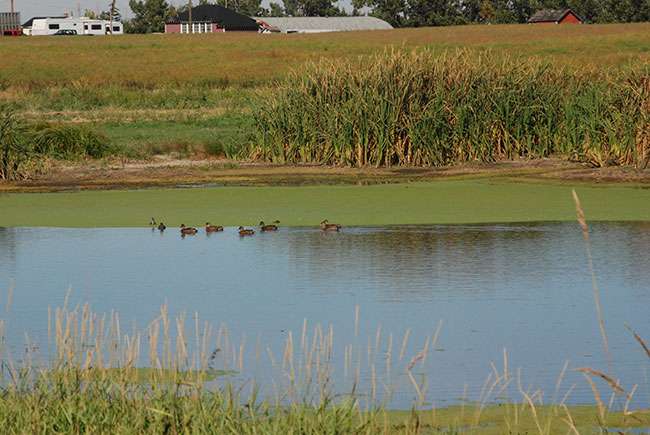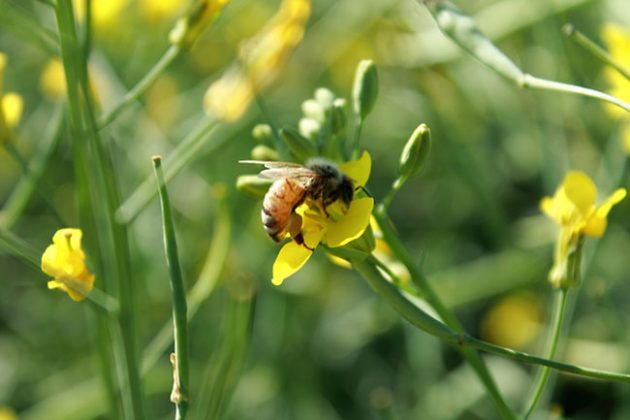
Features
Agronomy
Unfarmed spaces support agriculture production
Abundance and diversity of pollinators and beneficial insects can contribute to canola yield.
May 17, 2019 By Donna Fleury
 Maintaining in-field wetlands, natural habitats and unfarmed spaces can improve the abundance and diversity of native beneficial insect communities, with possible pollination benefits for farmers growing crops such as canola.
Photo courtesy of BRUCE BARKER.
Maintaining in-field wetlands, natural habitats and unfarmed spaces can improve the abundance and diversity of native beneficial insect communities, with possible pollination benefits for farmers growing crops such as canola.
Photo courtesy of BRUCE BARKER. Pollinators and beneficial insects can be important contributors to crop production and yield for prairie crops like canola. Natural habitats and uncultivated spaces can improve the abundance and diversity of these native beneficial insect communities. Researchers are interested in learning more about the role that unfarmed spaces have in supporting these insect communities and the potential for increasing crop yield.
“We have several projects underway in our lab, including an understanding of how natural and agricultural landscapes may affect the ecosystem services of pollinators and beneficial insects and crops,” explains Paul Galpern, associate professor in the department of biological sciences at the University of Calgary. “From a landscape perspective, we are interested in looking at small unfarmed areas that may border or be included in cultivated fields and what difference that might make. We questioned whether these messy bits, such as small wetlands, fence lines, remnant grasslands, forested areas or shelterbelts or other unfarmed spaces in and around cultivated fields were good for yield. We wanted to know if more of this type of habitat would make a difference in the field across major prairie crops.”
Higher canola yields
In a recent project, Galpern and his team looked at crop insurance data since 2012 in Alberta to determine if there were any differences. The available data was a larger aggregated set at the county or municipality level. “Our analysis showed that in municipalities that tend to have more unfarmed or complex areas in their fields, these areas have a small positive association with yields. We found that canola yields are higher than average in municipalities with more unfarmed areas in their fields, after controlling all other variables such as weather, climate and varieties,” he says.
“This shows there is a correlation between these factors, but we will need to dig deeper to determine if this works at an individual field level and what mechanisms are involved. We have evidence from many studies in Europe that more uncultivated or unfarmed spaces in a farmed landscape improve habitat for pollinators and other beneficial insects that pollinate crops such as oilseed rape, and that these have a small effect on yield. We expect to see similar results in canola in Canada and that’s why we are looking.”
Boosting pollinators and beneficials
In another large landscape-level study across agroecosystems in southern Alberta, Galpern and his team looked at the impacts on yield from beneficial insect visitation. They studied the role of natural habitats near canola fields as reservoirs for pollinators and natural enemies of canola pests, as well as the capacity of these beneficial insects to increase seed yield through pollination and pest reduction.
Across a wide area, they sampled beneficial insects (including pollinators, and predators of insect crops such as beetles and spiders) and developed estimates of abundance and diversity, and of crop yield to determine how these unfarmed features impact insect communities. To better understand habitat required by pollinators such as native bees for nesting and foraging and to quantify the role of in-field wetlands, researchers also sampled native bees at three distances from the wetland margin into the surrounding cropland (zero metres, 25 metres and 75 metres) across the season in three field types (canola, cereal and perennial grassland).

Beneficial insects, including pollinators and predators of insect crops, can contribute to a canola yield increase. Photo courtesy of Azara Effect Productions.
“As part of the project, we were trying to measure what we call spillover effects, such as native bees or predatory beetles and spiders that are using wetlands or unfarmed spaces as homes and nesting sites, and eventually move out into the crop to feed as pollinators or to attack crop pests such as flea beetles or others,” Galpern explains.
“Our results showed evidence that pollinators are based in wetlands, nesting in the margins and spilling over into the fields. We found that native bee abundance and diversity decreased further away from the margin of wetlands in both canola and cereal fields. This shows there is a positive benefit of maintaining in-field wetlands and unfarmed spaces, with possible pollination benefits for farmers growing crops such as canola.”
Cost/Benefit analysis
Although there are clearly benefits to pollinator and beneficial insect abundance and diversity by keeping these unfarmed areas intact, Galpern adds the next question is do these landscape features provide enough benefits or services to make it worthwhile for growers to maintain them in their fields? When we add all of the pieces of the puzzle together, the benefits are not zero, but does it add enough yield or other conservation benefits to encourage growers to keep them on the landscape?
There may be other reasons to keep these unfarmed spaces, such as the impacts and benefits for carbon sequestration or other sustainability measures that may be monetary or for social license. For example, the rotational footprint of crops across Alberta, Saskatchewan and Manitoba is estimated to be twice the footprint of the United Kingdom. So even a small increase in yield or other conservation ecosystem services will have a measurable impact on any of those metrics, whether it is carbon storage, sustainability or crop yield and food production.”
Galpern and a small group of colleagues from across the Prairies have come together to continue to explore these questions in this relatively new and evolving area of research where little is known. “We are really interested in big data in my lab, so we are looking at the opportunity to work with growers and leverage the information they are collecting through precision agriculture systems to help us look for patterns and answer questions,” Galpern adds. “For example, with enough precision harvest data, we hope to identify these trends as yield halos around wetlands – essentially areas of higher yield around unfarmed patches. We are also looking to see if there is an increase in yields per acre in fields that have more wetlands and other unfarmed spaces within their margins.
“We want to be able to look at not just yield benefits, but also profitability benefits and what does it mean for the overall bottom line. Growers care about both the economic and the environmental bottom lines, as do consumers and the public. I believe it is possible to have a win-win across agriculture land in the prairies and uses these unfarmed spaces to find a sustainable balance between conservation and farming.”